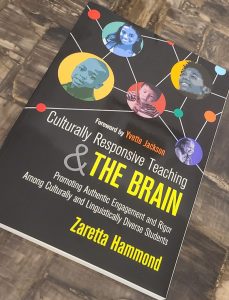“Culturally Responsive Teaching and the Brain” by Zaretta Hammond (2015) explores the intersection of culturally responsive teaching practices and brain research. The book delves into how teachers can better engage and support students from diverse cultural backgrounds by understanding how the brain processes information and responds to different instructional methods. It addresses the critical need for educators to acknowledge and embrace students’ cultural identities and backgrounds while fostering optimal learning experiences in the classroom. This book offers valuable insights into how educators can effectively engage diverse learners and create inclusive learning environments.
Cultural Diversity and Educational Equity:
The book begins by highlighting the importance of cultural diversity in the classroom and its direct impact on educational equity. It discusses how students from various cultural backgrounds bring unique perspectives, experiences, and learning styles, which educators can leverage to enrich learning. Hammond emphasizes the significance of understanding the cultural influences that shape students’ cognitive development and the role of educators in acknowledging and respecting these influences.
Neuroscience and Learning:
In the following chapters, the book delves into neuroscience and its implications for teaching practices. Hammond presents research findings that shed light on how the brain processes information differently based on cultural background and experiences. By understanding these neural mechanisms, educators can tailor their instructional methods to match the diverse needs of students, thereby optimizing learning outcomes.
The Cultural Learning Framework:
Hammond introduces the Cultural Learning Framework, a practical and evidence-based model designed to guide educators in implementing culturally responsive teaching strategies. The framework provides insights into understanding cultural norms, community dynamics, and the impact of stereotype threat on student performance. It also emphasizes the role of the teacher as a cultural broker, fostering trust and building strong relationships with students and their families.
Culturally Responsive Pedagogy in Practice:
The book explores various culturally responsive pedagogical practices educators can integrate into their classrooms. Examples include incorporating culturally relevant texts, integrating students’ cultural practices into the curriculum, and promoting collaborative learning to encourage cultural exchange among students. Hammond emphasizes the significance of teaching students metacognitive strategies to develop self-regulation and critical thinking skills. Hammond provides practical examples and case studies throughout the book to illustrate how culturally responsive teaching and brain-based strategies can be implemented in various educational settings. The author emphasizes teachers’ continuous growth and development in their journey toward becoming culturally responsive practitioners.
Implicit Bias and Stereotype Threat:
Addressing the prevalent issue of implicit bias and stereotype threat, Hammond highlights these factors’ negative impact on student’s academic performance and self-esteem. The book offers practical guidance on how educators can identify and mitigate their biases and create an inclusive and supportive learning environment that fosters student success.
Professional Development and Teacher Training:
The book underscores the need for ongoing professional development and teacher training to equip educators with the knowledge and skills necessary to implement culturally responsive teaching practices effectively. It advocates for school-wide efforts to promote culturally responsive education and create a collaborative and supportive learning community for teachers and students.
Culturally Responsive Teaching and the Brain by Zaretta Hammond is an indispensable resource for educators and educational stakeholders seeking to create inclusive learning environments and improve academic outcomes for diverse student populations. By bridging the gap between neuroscience and culturally responsive teaching, Hammond offers practical and evidence-based strategies to nurture all students’ cognitive, emotional, and social development, regardless of their cultural backgrounds. Embracing cultural diversity in education empowers students and contributes to a more equitable and socially just society.

